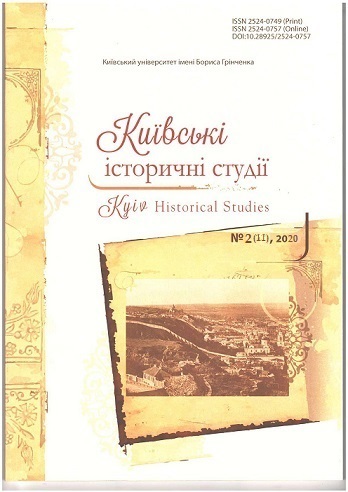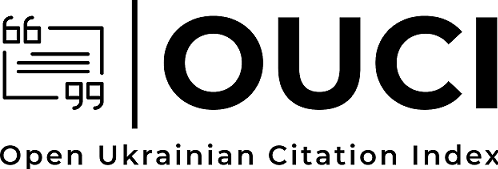CAMP DAILY ROUTINE OF UKRAINIAN PROFESSORS-HUMANITARIANS: BAMLAG
DOI:
https://doi.org/10.28925/2524-0757.2020.2.15Keywords:
Stephan Taranushenko, Vasyl Dubriovskyi, Dmytro Gordieiev, Vsevolod Zummer, Ukrainian humanitarians, BAMLAGAbstract
The Ukrainian humanitarian intellectuals became the object of the totalitarian regime repressions at the end of 1920–1930s. Ordinary social conditions of cultural life centers changed drastically. Even harsher conditions waited for the repressed humanitarian intellectuals — the conditions of Stalin’s GULAG prisons, concentration camps, and an exile. The survival strategies at GULAG’s extreme conditions had many differences and yet had common features. The subject matter of this article is an daily routine of the Ukrainian humanitarian intellectuals in 1930s. The objective of this research is to reflect upon the everyday life of well-known Ukrainian scientists, professorshumanitarians Stephan Taranushenko, Vasyl Dubriovskyi, Dmytro Gordieiev, and Vsevolod Zummer, who at different times were connected to Kyiv and its scientific environment. They met at BAMLAG (Urulha, Svobodniy) — where they were constructing the Baukal-Amur highway and two ways of Transsyb. Social transformations in the concentration camp had a sweeping character. But the Ukrainian humanitarians worked hard, under the psychological and ideological pressure, to the extent possible were doing art as well. The humanitarians of those days were forced to show their loyalty to the totalitarian regime. The sources for this paper are not only Vasyl Dubrovskyi’s memorials of concentration camp but also the documents and memoirs of Ivan Chystyakov, who at that time was a commander of BAMLAG security division. It was reflected how the prisoners were forced to a more productive work. The camp administration used food and the early release conditions to achieve that. The conclusion was the next — the Ukrainian professors managed to survive and left BAMLAG before the date due.
Downloads
References
Belykh, N. Yu. (2011). Ekonomika GULAGa kak sistema podnevolnogo truda (na materialakh Viatlaha 1938‑1953 gg.). M.: Rossyiskaia polytycheskaia entsiklopediia (ROSSPEN) [in Russian].
Bilokin, S. (2013). Masovyi teror yak zasib derzhavnoho upravlinnia v SRSR (1917–1941 rr.): Dzhereloznavche doslidzhennia, Vol. 2, Drohobych: «Kolo» [in Ukrainian].
Bon, O. (2016). D. P. Hordieiev ta diialnist kharkivskykh mystetstvoznavtsiv u 1920–1930 rokakh. Kyivski istorychni studii – Kyiv Historical Studies, 1, 70–78 [in Ukrainian].
Dubrovskyi, V. (1965). 2-yi Viddil BAMLAH’u HPU-NKVD. New York. In Nasha Batkivschyna [in Ukrainian].
Dubrovskyi, V. V. (2020). «Dribni zamitky na velyki temy»: Storinky memuariv ta publitsystyky. V. A. Kazymir (Comp.); O. B. Kovalenko (Ed.). Kharkiv; Chernihiv: Vydavets Oleksandr Savchuk [in Ukrainian].
Elantseva, O. P. (2000). BAMLAG v kontekste ystorii i literatury [30-ie gg. ХХ v.]. Vladivostok [in Russian].
Elantseva, O. P. (1996). Stroitelstvo Baikalo-Amurskoi zheleznodorozhnoi magistrali(30‑ie – nachalo 50‑kh godov): istoricheskyi opyt [Construction of Baikal-Amur Railway (30s – early 50s): historical experience]. (Extended abstract of Candidate’s thesis). Vladivostok [in Russian].
Ivanova, G. M. (2006). Istoriia GULAGa, 1918–1958: sotsialno-ekonomicheskyi i politiko-pravovoi aspekty. M: Nauka [in Russian].
Borodkin, L. I., Krasilnikov, S. A, Khlevniuk, O. V. (Ed.). (2013). Istoriia stalinizma: Prinuditelnyi trud v SSSR. Ekonomika, politika, pamiat: materialy mezhdunarodnoi nauchnoi konferentsii. M.: ROSSPEN) [in Russian].
Istoriia stalinskogo GULAGa. Konets 1920-kh – pervaia polovina 1950-kh godov: Sobranie dokumentov v 7 t. T. 3. Ekonomika GULAGa. (2004.). M.: «Rossiiskaia politicheskaia entsiklopediia» [in Russian].
Kazymir, V. A. (2018). «Pravda i dobra volia peremozhut”. Zhyttia ta diialnist Vasylia Dubrovskoho v Ukraini (1897–1943). Kharkiv‑Chernihiv: Vydavets Oleksandr Savchuk [in Ukrainian].
Kazymir, V. A. (2013). Naukovo-pedahohichna ta hromadska diialnist V. V. Dubrovkoho v Ukraini [Scientificpedagogical and Public Activity of V. V. Dubrovskyi in Ukraine]. (Extended abstract of Candidate’s thesis). Chernihiv [in Ukrainian].
Nazarenko, T. (Еd.). (2013). Tomskii lyteraturnyi nekropol. Tomsk: “Krasnoe znamia” [in Russian].
Nestulia, O. O. (1991). Doslidnyk narodnoho mystetstva (S. A. Taranushenko), Represovane kraieznavstvo (20‑30‑i roky). (рр. 172–177). K.: Ridnyi krai [in Ukrainian].
Parshyn, E. V. (2008). Literatory v lageriakh BAMLaga-AmurLaga-SvobodLaga. Svobodnenskii kurier, № 50, 10 dekabria 2008 [in Russian]. http://vvv.proza.ru/avtor/8h9dfmv
Pobozhii, S. (1998). Olena Nikolska. Portret na tli totalitarnoi doby. Pamiatky Ukrainy, 1, 116–123 [in Ukrainian].
Priadkin, V. M. Neyzvestnyi BAM [in Russian]. https://proza.ru/2013/01/16/347
Tykhmeniov, F. (2014). Izbrannoie. Tomsk [in Russian].
Chystiakov, I. (2014). «Sibirskoi dalnei storonoi. Dnevnik okhrannika BAMa, 1935-1936». M.: AST: TsORPUS [in Russian].
Shcherbakova, I. (2014). Predisloviie. «V dnevnike vsia moia zhyzn». Ivan Chistiakov I. Sibirskoi dalnei storonoi. Dnevnik okhrannika BAMa, 1935–1936. M.: AST: TsORPUS [in Russian].
Published
How to Cite
Issue
Section
License
Copyright (c) 2020 Олександр Бонь

This work is licensed under a Creative Commons Attribution-NonCommercial-ShareAlike 4.0 International License.
Authors who publish in this journal retain the right of authorship of the work and give to the journal right of first publication of this work under the conditions of Creative Commons: Attribution-NonCommercial-ShareAlike 4.0 International (CC BY-NC-SA 4.0), which allows others freely distribute the work published with reference to the authors of the original work and the first publication of this magazine.














